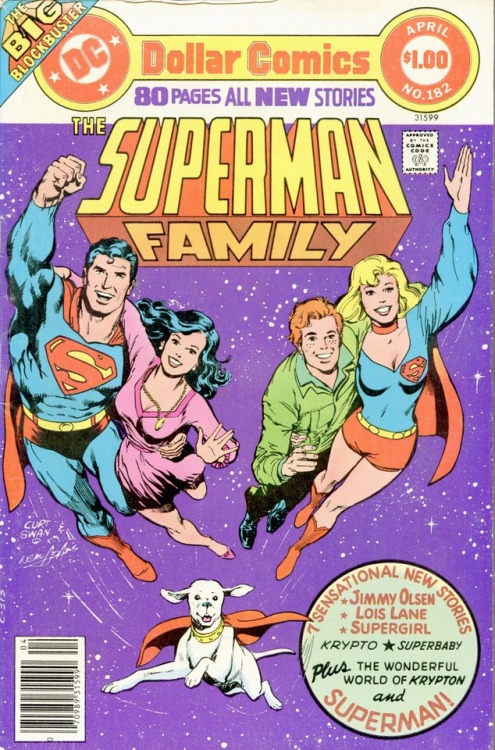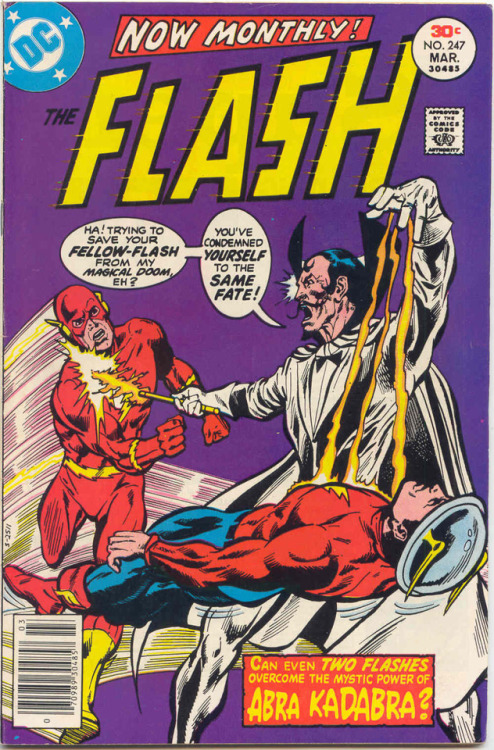#jeanette kahn
It was shortly before Christmas 1976 that I picked up this issue of BATMAN FAMILY, the last issue of the series that would feature reprints. After this, new Publisher Jeanette Kahn’s dislike for reprinted material in ongoing titles would change the series to being all-new–a double-edged decision as far as i was concerned, as much of the reason I bought BATMAN FAMILY was for the classic reprints. But the times were changing.

The all-new lead in this particular issue was touted as the first full-length Batgirl solo story ever done. But it wasn’t really a solo tale at all, as writer Bob Rozakis took the opportunity to reintroduce Batwoman in this story. I knew who Batwoman was, had seen her in a couple of reprinted stories over the years, but this was her first new appearance in something like 13 years, which was an eternity to me at the age of 9. I’d guessing that Rozakis was motivated to bring Kathy Kane back based on those older stories as well as a liking for the character–he’d use her and her protege, the original Bat-Girl, a number of times in the next couple of years.

The story opens with the action already underway, as Batgirl grapples with a pair of classic Batman foes: Killer Moth (her first villain) and the Cavalier. But the tables are turned on the bad guy duo when Batwoman leaps into the fray, thus evening the odds. With that, Batgirl’s thoughts turn back to how this turn of events happened: after getting a fan letter suggesting that she herself should change her nomenclature to Batwoman, Batgirl was invited to the first anniversary of the Island of 1,000 Thrills that she and Robin had saved in a previous BATMAN FAMILY adventure.

On the way, she comes across the Cavalier in the midst of an attempted theft and easily dispatches him–he’s got an aversion to fighting women. Thereafter, at Dick Grayson’s suggestion, Barbara looks up Kathy Kane, an old friend of Dick’s and Bruce Wayne’s, and who unbeknownst to her was once Batwoman. The two incognito bat-ladies stroll after lunch, coming across another robbery in progress, this one being committed by Killer Moth. Barbara breaks away from Kathy in order to become Batgirl, and our story loops back around ti its beginning.

But the Cavalier seemingly grows to giant size, and he and Killer Moth escape. Batgirl dopes out that he’s using the illusion-casting apparatus of the Isle of 1,000 Thrills to make it seem like he’s a giant, and so forewarned, is in position to foil their next heist, an attempted hijack of a vintage Ironside ship. Making excuses to one another Barbara and Kathy become their Bat-selves, accidentally revealing their true identities to one another in the process.

From there, it’s action, action, action as the two crime-fighters beat the pants off of Killer Moth and the Cavalier. And in the wrap-up, Kathy declares her intention to remain retired and passes her mantle over to Barbara. but Barbara refuses it, saying that she intends to remain as Batgirl after all. And so this inconsequential story (a term I find I’m using for a lot of these entries lately) reaches its end. Not much happens apart from a bunch of fights, but it’s fun enough anyway, especially in seeing the two Bat-ladies compare stories.

The two reprints this time out are both Robin-centric, so as to make up for his absence in the opening story. The first is a relatively early Batman story from 1943 in which the brother of Dick Grayson’s father and his new wife arrive at Wayne Manor to take Dick off of Bruce Wayne’s hands.They are, of course, criminals looking for a payout from Wayne–and when the Batman gets involved, they bring in a gangster friend to help take care of the Masked Manhunter. It’s a good story, the best bits of which show both Bruce and Dick expressing how strongly they feel about one another (in a strictly father-son way, don’t get any ideas, Dr. Wertham!)

The second reprint is a mystery story, in which a cocky young Freddy Loyd takes Robin’s place, learning Batman’s true identity in the process and forcing him to take Freddy on as a partner as a result. But this is all a game, a put-on on the part of Dick Grayson–he’s actually disguised himself as Freddy to see if he can fool Batman and Alfred. but he’s dismayed when the duo seems to prefer Freddy to his true self. Angrily unmasking in front of them, he’s surprised to learn that they had seen through his subterfuge and decided to play along and teach him a lesson. And a fine time was had by all.
Post link
I bought this issue of SUPERMAN FAMILY at a supermarket of all places–a clear sign of the aggressiveness with which new DC publisher Jeanette Kahn was pushing her new initiative. Having come to the conclusion that one of the things that was causing the comic book business such ills was that the books weren’t as profitable for mainstream retailers as “real magazines”, Kahn initiated the Dollar Comics program: four titles would be converted into 80-page all-new releases priced at a dollar rather than thirty cents. This would generate better profit-per-unit for retailers and perhaps get the product into more outlets.
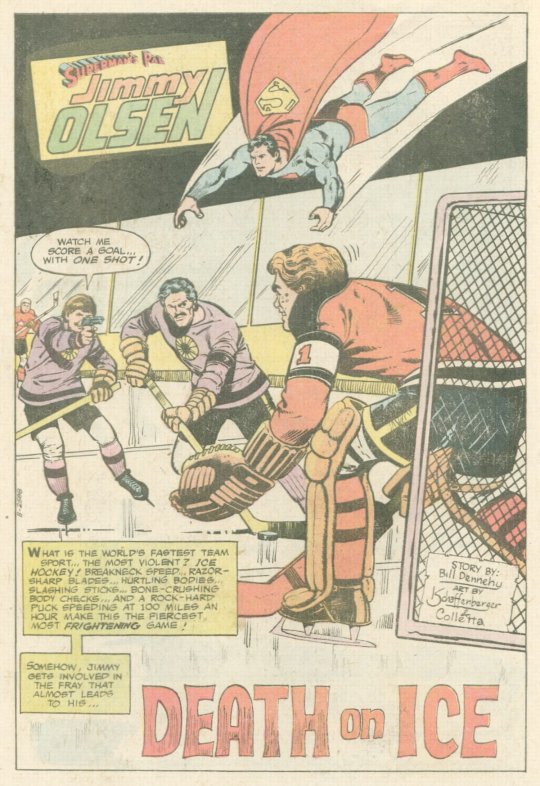
SUPERMAN FAMILY was the first of these books that I encountered–the others to make the shift to the Dollar Comic format at this time were WORLD’S FINEST, G.I. COMBAT and HOUSE OF MYSTERY–so two super hero titles, a war book and a weird mystery title, covering multiple genres to see what stuck. All of the books were anthologies, which helped with generating this much material on a monthly basis but which also made them all, in essence, less-than-essential buys. You could read SUPERMAN or BATMAN just fine if you avoided the Dollar Comics, for instance. I’m sure some of the thinking going into these choices involved not wanting to monkey around with the company’s true money-makers by converting them to an unproven format.

The Dollar Comics initiative lasted for a little over five years, though in that time, as you’d expect, the size of the books dwindled a bit, and the initial ads-free approach was eventually dropped. I don’t know that it had much of an impact one way or the other–certainly, none of the initial Dollar Comics titles was cancelled, at least not for that reason. But once they stopped being new, I don’t know that they opened up as many doors as Kahn had been hoping. Still, it was a worthy experiment.

If I had to pick one word to describe this inaugural edition of the Dollar Comics SUPERMAN FAMILY, it would be “nice”. All of the stories in it are competently done by seasoned professionals, they’re all well-constructed yarns. But none of them are particularly exciting or engaging or memorable–and, in fact, I didn’t remember a one of them until I cracked this book open again to write up this piece. They all represented five minutes of disposable entertainment, to be read and discarded without another thought.

There were seven stories in total in this issue, covering the length and breadth of the Superman line of characters, but focusing on the three series–JIMMY OLSEN, LOIS LANE and SUPERGIRL–which had been the backbone of SUPERMAN FAMILY for it’s run up to this point. In the opening Jimmy Olsen tale, the red-headed “Mr. Action” investigates shady goings-on in the world of Ice Hockey, with some assistance from the Man of Steel. The Superbaby tale that follows it up is about the infant from Krypton adopting an alien pet, who turns out to be a stranded alien pilot.
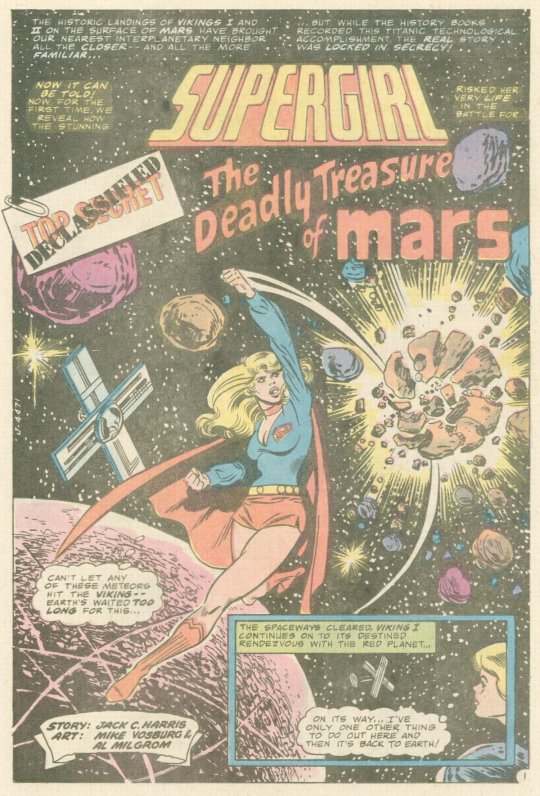
The third piece is a Lois Lane story that’s very similar to the Jimmy Olsen opener, except that Lois is investigating the world of professional wrestling. Superman is largely absent in this one, but he does appear for a panel or so at the end to wrap everything up. The next story is probably the one that took the greatest attempt to have substance, aided by the always-interesting artwork of a young Marshall Rogers. It’s a Fabulous World of Krypton outing that details that planet’s equivalent of the Christmas holiday, a celebration of the pacifist Jo-Mon whose death by violence brought about Krypton’s first lasting peace. It’s an obvious allegory, but it’s presented with sincerity and heart.

Next came a full-length Supergirl story nicely illustrated by Mike Vosburg, in which the Maid of Might engages in a rare battle with her cousin’s arch-enemy Lex Luthor. Luthor is after a sample of Kryptonite which rests on the surface of Mars–this was during that time period where all of the Kryptonite on Earth had been transmuted into lead, so the stuff was a bit more rare. And it’s a fake anyway, a ruse by Supergirl to draw out Luthor. That’s followed up with a light Krypto story in which the flying canine first emasculates and then restores the confidence of a protective junkyard hound. Truly these were life-and-death stakes.

The book closes on another Jimmy Olsen story, in which the reporter is gifted with telepathy by an imperiled mentalist and has to come to his aid. Once again, it’s Superman who does most of the heavy lifting here. So it was a nice, think package, of the sort that always appealed to me as a kid. And yet, I found it unfulfilling–there wasn’t anything in the issue that I found especially memorable, which was almost never the case in a comic book this large. So it would be a while before I sampled another issue of SUPERMAN FAMILY.
Post link
The mailman brought my latest subscription copy of FLASH that contained big news! One of the first decisions made by new incoming publisher Jeanette Kahn was to do away with the 8-times-a-year release model. It’s difficult to believe today, but for thirty years, even titles such as SUPERMAN and BATMAN didn’t come out more than 8 times a year. (The anthologies titles such as ACTION and DETECTIVE did maintain a monthly schedule.) This was due to concerns about overexposure and the need for more time to ensure quality and so forth–but by the mid-1970s, when almost all of the Marvel books were monthly, it didn’t make sense to leave some of your best sellers off the shelf four months out of the year.

Coincidentally, this was also the issue where the Flash got full title to his series back again. Green Lantern had been moved out into his own revived magazine, and now the Scarlet Speedster had a full book in which to shine. There’d still be the occasional back-up tale, especially on those occasions when the overall size of DC’s books was increased in page count. But book-length tales was now the name of the game.

So we open up where the previous chapter left off: in the 64th Century, wherein Flash has been captured and incarcerated by the authorities for his seeming execution of the villainous magician Abra Kadabra. Barry is being held in a special futuristic cell whose walls are able to match his vibrational rate, preventing him from phasing through them. His efforts to escape are all in vain. He’s convinced that Abra’s demise was all a trick, and so the criminal illusionist is on the loose doing who-knows-what–so it’s imperative that he regain his freedom.
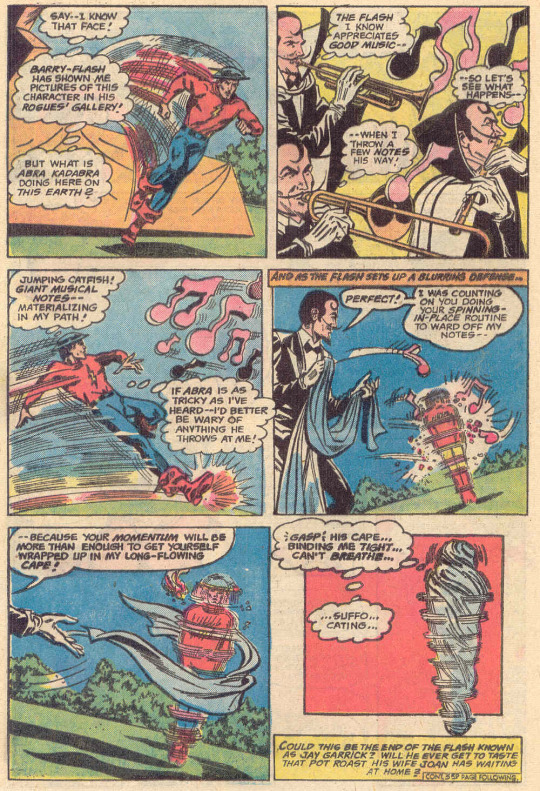
Meanwhile, Abra has used the energy of the Flash’s seemingly-fatal punch to propel himself back to the 20th Century. But when he arrives, he’s immediately confused, as the city is in the midst of a ceremony honoring his enemy, the Flash. but this is no Flash that Abra’s ever encountered before. And that’s because, in a fluke similar to that which Wonder Woman experienced in her own comic a short while ago, Abra’s trip tot eh past has crossed dimensional barriers, so he finds himself on Earth-2, confronting that world’s Jay Garrick Flash.

Back in the future, Flash figures a way out of his cell. He throws the one object of furniture in his cell–his chair–at the wall vibrating it at one frequency, then shifts his own frequency to a different wavelength, allowing him to penetrate the wall when it adapts to the speed of the chair. Even with this, Flash is immediately pursued by robot guardsmen, and has to fight his way to freedom.

The comic pauses at this point for the inaugural edition of the Publishorial, a new regular feature written by newly-arrived publisher Jeanette Kahn in which she attempts to commune with the readership in Stan Lee style. It’s an honest and earnest attempt, but like so many others both before and since, Jeanette is no Stan Lee, and lacks his ease of patter and mix of gregariousness and bombast. Meaning that most of these pages are a bit of a snooze (or were to me when i was a kid, anyway.) I did like Neal Adams’ goofy portrait of Jeanette, though.

This issue also announced the advent of a new DC feature, the DC Hot-Line. Essentially, this was a toll-free phone number that played a pre-recorded message made by one or another of the DC editorial and creative staff plugging upcoming story events and releases. It was a number that I dialed a lot throughout the year or so it was in service–it was always impossible to get through on a Monday, which is when the new messages would be posted. I can remember that the recording technology was terrible enough that it often took three or four repeat calls before you could make out the full gist of what was being said. Still, it was a neat idea.

Back on Earth-2, Abra Kadabra has captured jay Garrick, but he’s still confused, thinking that Jay is his old foe in some new costume. By playing dumb, Jay tricks Abra into outlining the events of his escape and Barry’s predicament. Meanwhile, Flash has continued his battle with is pursuers, using one of the robots to re-enact his destruction of Abra and thereafter following Abra’s trail back through time. He arrives in time to snatch Jay out from right under Abra’s nose.

From there, after a short scuffle, the twin Flashes are able to knock Abra back through time to his native 64th Century, where his reappearance proves Barry’s innocence and the magician is once more incarcerated. A fun if inconsequential tale and a decent wrap-up to what was a pretty underwhelming set-up installment last month.
Post link


